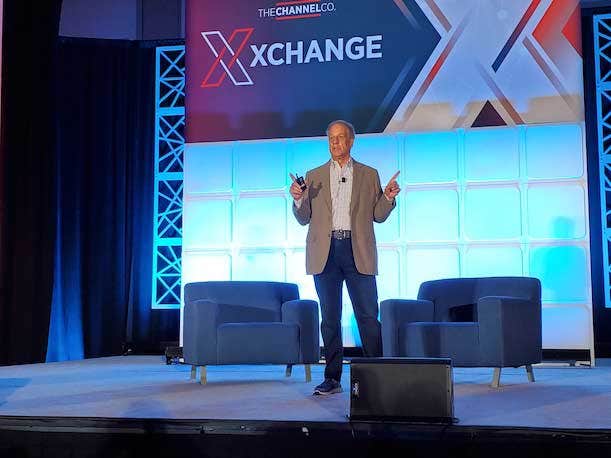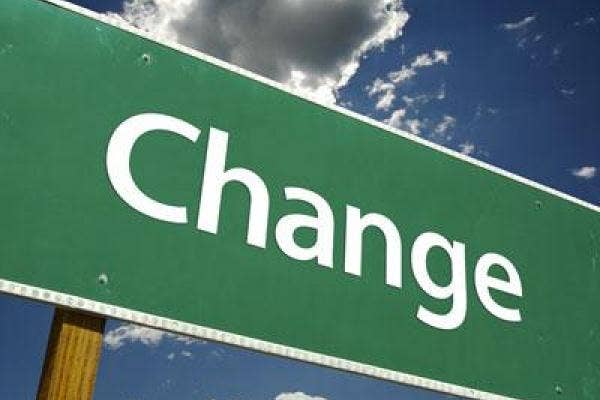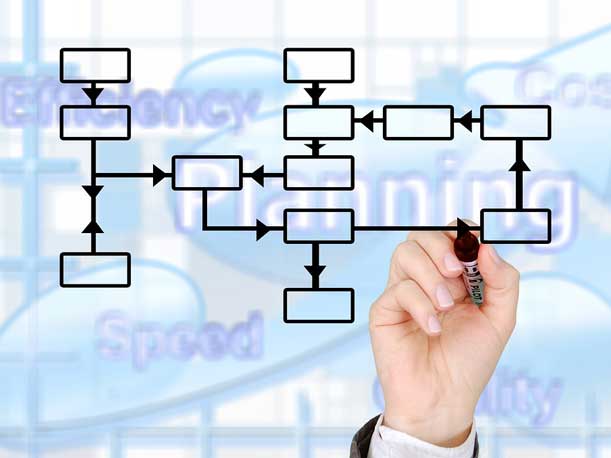GTDC CEO Vitagliano: Distributors Are Evolving To Be ‘Ecosystem Orchestrators’
‘The ability to do the compatibility testing, the ability to have the interaction with the vendor community, the ability to help you all navigate all of the providers that are out there, particularly in the security space, somebody’s got to be able to help with that. And distributors can and will have the capability to do that,’ says Frank Vitagliano, CEO of the Global Technology Distribution Council, at XChange March 2023.

Not Your Father’s Distributors
While IT distribution is still often thought of as the way boxes of IT products get packed for shipment to the channel, in reality that activity plays an ever-decreasing role for the world’s distributors.
Frank Vitagliano, CEO of the Global Technology Distribution Council, or GTDC, an organization that includes 20 of the world’s largest distributors, told solution providers and MSPs at this week’s XChange March 2023 conference in Orlando, Fla., that distribution instead is changing at a rapid pace. XChange is hosted by CRN parent The Channel Company.
Vitagliano said that when he took on the leadership role at GTDC in 2019, there was a lot of discussion going on about the future of distribution.
[Related: Ingram Micro, TD Synnex, D&H CEOs On The 2023 Economic Outlook]
“We have marketplaces getting created, and distribution is going to get disintermediated—I’ve been around a long time and been hearing that forever. And I didn’t buy it. ... I’ve been in the industry for a long time, as a vendor executive and channel chief for a couple of companies and also as a solution provider executive. And in all those jobs, I worked very closely with distribution and relied on it. So I really didn’t agree with what I was starting to hear.”
Instead, IT distributors are actually becoming what Vitagliano called “ecosystem orchestrators” given the role that they play not in shipping product but in coordinating the activities of and communication between vendors, solution providers and customers.
IT distributors are no longer merely a dot in the line between vendors and solution providers or customers, he said.
“Somebody’s got to be in the middle there to orchestrate all of that,” he said. “Because there’s a ton of work that needs to get done that many of you don’t want to make the investments in your business to do. Having run a solution provider for a couple of years, I know the cost associated with going to market with multiple vendors and making the investments in the new technologies. So you’ve got to find ways to defer some of that.”
Miguel Ribeiro, founder and sales leader of VBS IT Services, a Toronto, Ontario-based MSP, told CRN he has seen challenges related to vendor complexity and integration with the channel.
“From a delivery standpoint, all distributors do a good job,” Ribeiro said. “I think there needs to be more investment in the tools and platforms to give us ease of integration into our systems. I think that will make a big difference in how we adopt some of the new products and services.”
That investment in tools and platforms is ongoing and is increasingly focused on the kinds of platforms needed to orchestrate the more complex business models solution providers need from their distributors, Vitagliano said.
Here is a look at the future of distribution and the concept of ecosystem orchestrator.

COVID-19: Distribution Proved Its Unique Value
GTDC in October 2019 published a study called “IT Distribution 2025” as a way to look forward to what distribution would look like in the future. That study, which included talking to venture capitalists, vendors, solution providers and even some end users, came out shortly before the COVID-19 pandemic hit, Vitagliano said.
The survey showed how distribution had evolved from the simple shipping of products to providing complete offerings that solution providers and MSPs could take to customers, he said.
“There’s billions of dollars of investment that’s been put in place over the years,” he said. “And [distributors] built on that, and it enables them to operate and provide operational excellence to all of you at scale. And that has continued and those investments have continued.”
The impact of those investments were never as obvious as when the global pandemic struck in early 2020, Vitagliano said.
“The thing that I want you to really understand here is within three months, four months of this study being released, we were now in the pandemic, which was one of the most significant events in my lifetime, and certainly many of us,” he said. “And one of the things, if you think back, that was really interesting is the IT supply chain kept flowing.”
Part of that was the fact that distributors typically carried 45 days to 60 days of inventory and were able to use that to keep products flowing to the channel, Vitagliano said. But at the same time, distributors quickly moved their employees to work-from-home mode and figured out how their warehouses could get products out the door.
“The supply chain kept flowing,” he said. “And it kept flowing amazingly well. We heard stories about food supply chains, paper goods supply chains, all kinds of issues in other supply chains. And the IT piece flowed pretty well. And obviously, we hit a little wall a year and a half or two years later with some of the supply chain issues that we encountered. But the role that distribution put in place … worked extraordinarily well.”

Distribution Is Continually Evolving
Distribution continues to evolve, and is now doing so in three major ways, Vitagliano said.
First, distributors have transitioned to become an ecosystem orchestrator, he said.
“That doesn’t quite roll off your tongue,” he said. “So you have to kind of think about that a little bit. And the term ‘ecosystem’ is overused by a lot of people.”
Second, distributors are making major investments in digital platforms and marketplaces for obvious reasons, Vitagliano said.
“Every distributor, that’s the No. 1 area of investment that they’re making,” he said. “And we’re talking about significant amounts of dollars because these folks are generating big revenues. The largest distributor globally is $60 billion or so [in revenue], closely followed by $50 billion. So they’re, we’re talking about major, major investment dollars. We’re talking about billions of dollars being invested.”
Third, distribution is now all about using data to drive insight and business outcomes, Vitagliano said.
“[They have] to be able to help provide you all with more capability, more enablement for you to transact business with your customers,” he said.

Distributors Becoming Ecosystem Orchestrators
IT distribution is at the center of an ecosystem that is really a network of vendors and solution providers all looking to work together to sell and support products and services for end users, Vitagliano said. This, he said, is far removed from the traditional linear model where distribution was just in the line between vendors and solution providers or customers, he said.
“Somebody’s got to be in the middle there to orchestrate all of that,” he said. “Because there’s a ton of work that needs to get done that many of you don’t want to make the investments in your business to do. Having run a solution provider for a couple of years, I know the cost associated with going to market with multiple vendors and making the investments in the new technologies. So you’ve got to find ways to defer some of that.”
IT distributors play that orchestration role, Vitagliano said.
“And honestly, who else could do that?” he said. “There’s nobody else in the industry that could play that role, that’s equipped to play it.”

Driving The Move From Distribution To Ecosystem Orchestration
Several factors are driving the new role of ecosystem orchestrator, Vitagliano said. These include the increased complexity of IT, increasingly diverse IT environments, and evolving customer demands around their focus on business outcomes and multivendor solutions, he said.
“And nobody else can do that,” he said. “Nobody else can put that together. The ability to do the compatibility testing, the ability to have the interaction with the vendor community, the ability to help you all navigate all of the providers that are out there, particularly in the security space, somebody’s got to be able to help with that. And distributors can and will have the capability to do that.”
Furthermore, Vitagliano said, the growth in digital platforms is driving distributors to become ecosystem orchestrators as digital platforms are the only way for the various ecosystem players to bundle and integrate multivendor and/or multi-cloud solutions.
“The typical solution consists of seven or eight different supplier/vendor products,” he said. “And then there’s the work of sourcing, provisioning management solutions, consolidated billing, and again, somebody’s got to do all that.”
While some solution providers may try to do that themselves, it’s difficult, particularly as the hardware side of those solutions become an increasingly smaller part of the work, Vitagliano said.
“There’s all this other stuff that needs to be done that can be done efficiently with operational excellence at scale, and distribution does that,” he said.
Finally, IT distributors as ecosystem orchestrators allow data-driven insight and business outcomes, Vitagliano said.
“The question is, how can we go beyond the basics of providing you with credit, service, technical support, all the things that when I go to the list, people’s eyes tend to kind of glaze over,” he said. “But in addition to all of that, you really need multivendor, multi-artner data insights. And who better to provide that than folks that have been supporting you for the last three years? That data exists for your customers. [Distributors] understand who you’re selling to. They know what you’re selling to them. And they know when you’ve sold it to them. And that supports new and expanded revenue streams.”

The Trust Factor In Distribution
One thing that solution providers can be sure of when working with distributors is that the trust that’s been in place for all the years of their relationships will continue to be in place, Vitagliano said.
“So there’s no concern or confusion, or at least it shouldn’t be, over whether a distributor is going to go sell directly to your customer,” he said. “The vendor side, obviously, that’s been in place forever. And having been there for a long time, I would argue that there’s a certain set of customers and a certain set of opportunities where that makes sense.”
But when it comes to distributors, there is no debate over who their customer is, Vitagliano said.
“There’s a trust level that has been established and been in place for many years, and continues to be in place. And when I talk to folks like you about what they expect from their distributors, that becomes really the No. 1 item, and that will continue to be there.”

Transition To Services
Vitagliano said IT distribution’s transition toward a services focus is ongoing.
“One of the things that’s very significant is every vendor has introduced some sort of an as-a-service consumption model that is being driven by customer demand,” he said. “It hasn’t become really mainstream yet. I mean the volumes are probably in the single digits in terms of where we’re at, but it is becoming more significant.
“Eventually, they’ll figure out the best processes to be able to put in place and operate at scale,” he said. “And they’re not doing it today because every vendor has a slightly different implementation, and the major ones are driving the agenda almost on a one-on-one basis with industry. And there isn’t any sort of single platform or single process to put in place.
For managed services, it depends on their requirements, Vitagliano said.
“If it’s strictly a pure-play MSP, then in some cases the role that a traditional distributor provides could be limited for MSPs trying to take advantage of it. But there’s still a ton of experience, a ton of educational information available, and certainly the credit and financing still in place [from the distributors].”